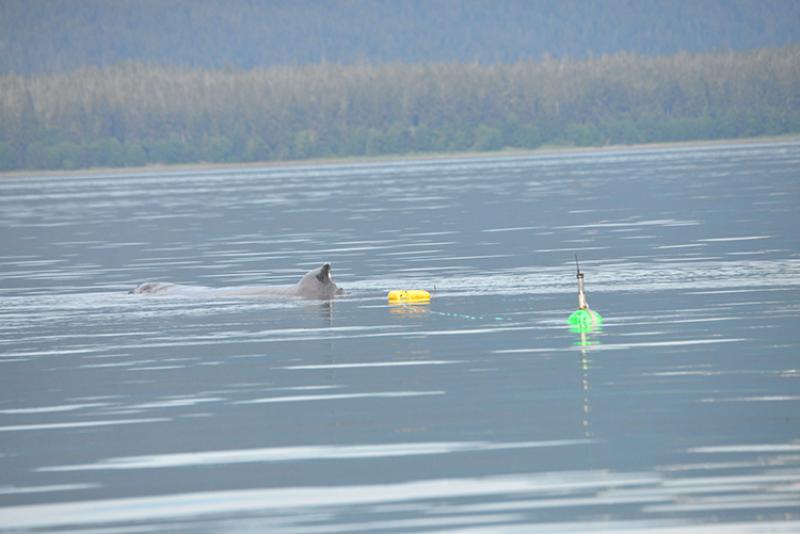NOAA’s Alaska Marine Mammal Stranding hotline received reports identifying two separate entangled whales in the Juneau area on July 3, 2023. NOAA Fisheries marine mammal experts are asking the public to keep an eye out for both whales. If spotted, do not take any hands-on response actions. Report the sighting to the hotline at (877) 925-7773, or the U.S. Coast Guard on VHF Channel 16 so that trained and authorized personnel may respond.
Whale #1
The first report came on Monday, July 3, just before 9 a.m. of a humpback whale entangled in recreational Dungeness crab pot lines near the North Douglas boat ramp.
The animal is a well-known local whale (number SEAK-5057), named “Manunauna” in the Juneau Flukes catalog. He is a male, and the whale-watching community refers to him as “Manu” for short. He has been seen feeding on herring within the inner harbor of Statter harbor earlier this summer and more recently lunge feeding at the surface in Fritz Cove.
“With the help of the U.S. Coast Guard, NOAA Fisheries colleagues at the Auke Bay Lab, and Alaska Whale Foundation, we attached a green rigid buoy with a satellite tag to the entangling materials on Manu on Monday, July 3,” said Large Whale Entanglement Response Coordinator Sadie Wright, NOAA Fisheries Alaska Regional Office. “We are tracking the whale and he has moved outside of the Juneau area and is headed south in Chatham Strait.”
Whale #2
The second entangled whale report came in on July 3 just before noon. A fisherman said a humpback whale had become entangled in their gillnet while they were fishing in Taku Inlet. He said the crew was able to cut off some of the net, but that the whale swam away with a maximum of 100 feet of gillnet and corkline wrapped around its flukes. He also reported some damage to his fishing vessel as a result of the encounter.
“We know less about this second animal,” said Marine Mammal Specialist Suzie Teerlink, NOAA Fisheries Alaska Regional Office. “It was estimated to be about 35 feet in length. We are asking the public to provide photos of this entangled whale so we can better assess the entanglement and perhaps identify the whale.”
How Can I Help?
When well-intentioned members of the public take matters into their own hands to try and save a whale, they put themselves and the animals at risk. Only experienced responders who have been authorized by NOAA Fisheries and who have the appropriate training, experience, equipment, and support should attempt to disentangle or closely approach an entangled marine mammal.
NOAA Fisheries is asking the public to report any resights of either of these humpbacks. The best way you can help entangled marine mammals is to immediately report sightings by calling the NOAA Fisheries Alaska Marine Mammal Hotline at (877) 925-7773, or the U.S. Coast Guard on VHF Channel 16.
When reporting an entangled marine mammal, provide the following information:
- Date
- Location of the animal (including latitude and longitude, if known)
- A detailed description of the entangling gear or debris
- Where the entanglement is located on the animal
- The behavior and direction of the animal
- Condition of the animal (alive or dead)
- Species (if known)
Photos or videos from different angles and from a safe and legal distance (for humpbacks, greater than 100 yards) can provide valuable information to entanglement response teams. If possible, monitor the animal from at least 100 yards away until you receive additional guidance from NOAA or an authorized response team arrives.



